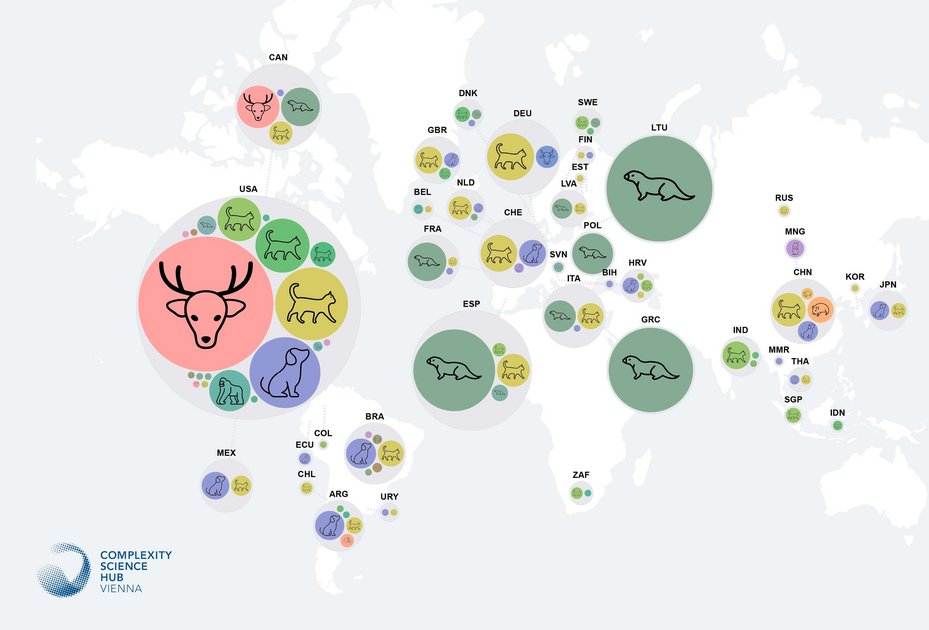- Home /
- University /
- Infoservice /
- News /
- Austrian research team develops COVID-19 dataset for animals
Research
Austrian research team develops COVID-19 dataset for animals
Besides its public health importance, SARS-CoV-2 is also a threat of unknown magnitude for animal health and welfare – as a direct result of the disease but also through preventive measures such as the mass culling of some infected animals. The University of Veterinary Medicine Vienna, in cooperation with the Complexity Science Hub Vienna, recently presented a dataset of SARS-CoV-2 infections in animals that will improve our knowledge on the complex epidemiology of SARS-CoV-2 at human-animal interfaces and help preventing future epidemics.

The virus that causes COVID-19 affects not only humans, but also non-human animals. And just as humans, some animals can infect other animals and, in rare cases, humans. Yet scientists know little about the animal species that are susceptible to SARS-CoV-2 and their potential role in the developing epidemiology of the disease.
Gaining a better understanding of the pandemic – and preparing for the next one
The dataset will make it easier to study the complex relationships between humans, animals and the virus. The international research team led by Amélie Desvars-Larrive from the Unit of Veterinary Public Health and Epidemiology at Vetmeduni, who also conducts research at the Complexity Science Hub Vienna, collected reports on SARS-CoV-2-infected animals worldwide from two public databases (ProMED-mail and WAHIS) to create an open access dataset called SARS-ANI.

"Understanding how SARS-CoV-2 spread between people and animals can help us to better manage the current pandemic and prepare for the next one."
Having this kind of information in one place rather than scattered among multiple sources handled by different organisations or government agencies will make it faster and easier to find, access, and re-use the data, e.g. to develop targeted sampling strategies or data-driven recommendations for international transport of certain animal species, the researchers said.
A dynamic dataset of SARS-CoV-2 events in animals
The SARS-ANI dataset, as well as its interactive dashboard (https://vis.csh.ac.at/sars-ani/) is dynamic, i.e. it grows as more animals are tested and reports shared. The researchers hope this will help to track and better understand SARS-CoV-2 animal infections but also raise awareness on the risk of human-to-animal transmission. According to the first author of the study, Afra Nerpel of Vetmeduni´s Unit of Veterinary Public Health and Epidemiology, “The dataset provides detailed information on each animal cases and a unique overview of the susceptible species. It will enable further analytical studies on the potential impact SARS-CoV-2 has on animal health and welfare, conservation, and more generally the ecosystems”.
31 species identified as susceptible to SARS-CoV-2
To date, the dataset records 31 species in which the virus or antibodies against it have been detected. The data highlights that animals infected with SARS-CoV-2 may exhibit subclinical to severe signs of infection. Also, implemented interventions range from individual treatment to preventive culling. Animal infections usually result from human-to-animal transmission (also called “spillback”) and in certain cases can lead to further spread of the virus among conspecifics, as in hamsters, minks or tigers.
The number of reported cases in animals, if it has steadily increased since February 2020, shows currently a plateau, probably resulting from a drop in the number of animals tested and/or under-reporting of the cases to the World Organisation for Animal Health (formerly OIE).
The article “SARS-ANI: a global open access dataset of reported SARS-CoV-2 events in animals” by Afra Nerpel, Liuhuaying Yang, Johannes Sorger, Annemarie Käsbohrer, Chris Walzer and Amélie Desvars-Larrive was published in Scientific Data.